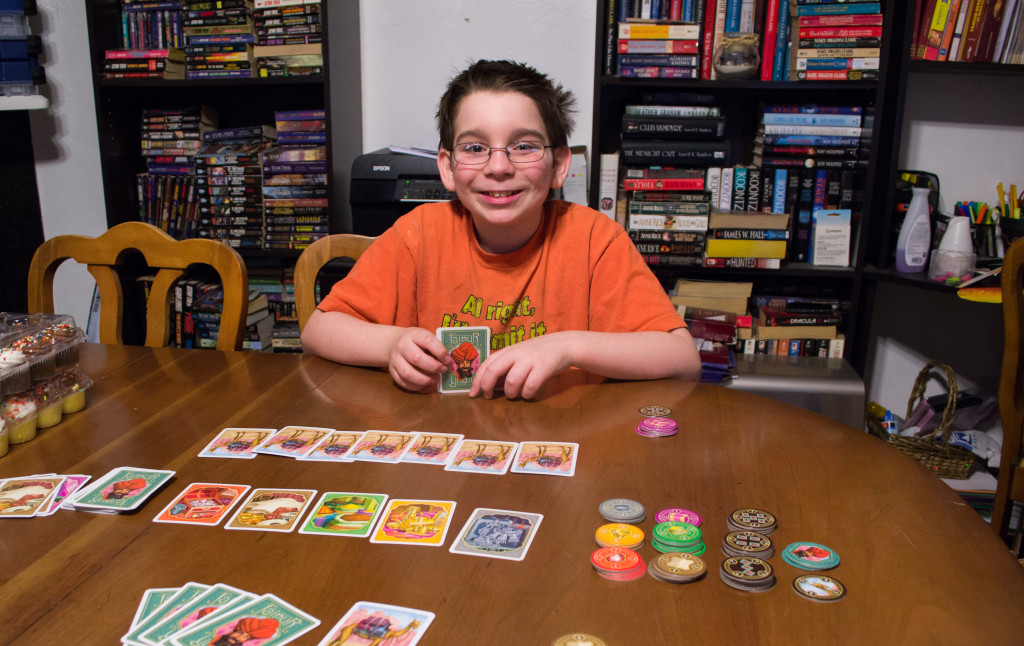“Jaipur” (J-uh-y-puur or Jiipour) is a set-collecting card game named after the capital and largest city of the Indian state of Rajasthan in Northern India. Players will be tasked with being richer than your opponent at the end of each week (round). To do that, they’ll be collecting sets of goods and exchanging them for rupees (more or less). How successful a player will be all depends on how well they manage the cards both in their hands and in the market at any point in time. The player who manages to be the richest at the end of the week gets a “Seal of Excellence” and the first player to receive two, wins the game.
Components
The game includes 55 goods cards, 38 goods tokens, 1 camel token, 18 bonus tokens, and 3 Seals of Excellence.
Setup & Gameplay
Players will start by placing three camels face-up in between the players to form the market. After that, the deck is shuffled and each player receives five cards to form their starting hand. Two more cards are drawn from the deck and added face-up to the market so that there are five cards (they can be camels too). The players will then look at their hand and place any camel cards they may have face-up in front of them. The goods tokens are sorted by type and stacked face-down in descending order of value. The bonus tokens are sorted by type and shuffled separately (again, face-down to hide the numeric values). A starting player is chosen at random.
On a player’s turn, they can only do ONE of the following:
1. Take Cards – A player may exchange several goods, take one good for free, or take all the camels from the market. If you opt to exchange multiple goods, you can replace them with a combination of camels (which are sitting in front of you) or cards from your hand. Cards are then drawn from the deck to replenish the market back up to five cards (if needed).
2. Sell Cards – A player can choose one type of good from their hand and discard as many cards of that good as they want. You’ll take as many goods tokens (of that matching goods type) as cards discarded. If you sell 3, 4, or 5 cards, you can take a 3, 4, or 5 bonus token. When selling diamond, gold, or silver, you MUST sell at least two cards.
The round ends when three types of good token piles are depleted or when there are no more cards left to refill the market. Each player flips over and counts the numeric values on the tokens…whoever has the highest total, wins a Seal of Excellence. More rounds are played until someone receives two Seal of Excellence tokens, in which case they win the game!
Editor’s Note: The above doesn’t cover all of the rules found in the manual, but should give you an idea as to how the game is played.
The Review
This game is deceptively simple until you get through your first game, which went by surprisingly quick during our initial playthru. After that point I was left wondering what I could have done better to create more sets and offset the luck of ever-changing market. In my first game I took a lot of free card actions in order to have more control over the sets I was creating. On my second time through, I opted to try a “camel” approach and scooped them up on a regular basis so that I could trade them in for multiple goods on the market. The downside to this approach is that you can only have seven cards (camels don’t count toward this limit), so you’ll probably need to part with one good type in order to get another that you’re currently going after.
Then there’s the bit about paying attention to what your opponent is collecting and discarding. He/She too is limited by a hand of seven cards, so they are more than likely going after one or two goods in particular. Being observant in this game will give you an edge, as you won’t want to supply your opponent with the good types they need to make a big play. Of course, you can offset this risk by using any camels you have stored up. You also won’t want to wait too long to make a play as the values of the good tokens decrease the more you sell. You might want to wait for a set of four cards before making a sale, for example, but you’re potentially opening the door for your opponent to grab the best tokens before you do. It’s a vicious but intense cycle that kept me engaged from the start of every round till its end. Not knowing what my point values actually were until the latter also helped to keep the suspense alive.
All in all, “Jaipur” is a decent two-player game that gives “Jambo” a run for its money. “Jambo” is a little more complicated, so I’d recommend that parents stick with “Jaipur” if they have younger children looking to try something new. The art is well-themed and eye-catching, so no complaints in that department. I bought my copy of “Jaipur” for twenty bucks on Amazon (link below) and don’t regret the purchase.
Final Verdict: 8/10
—


